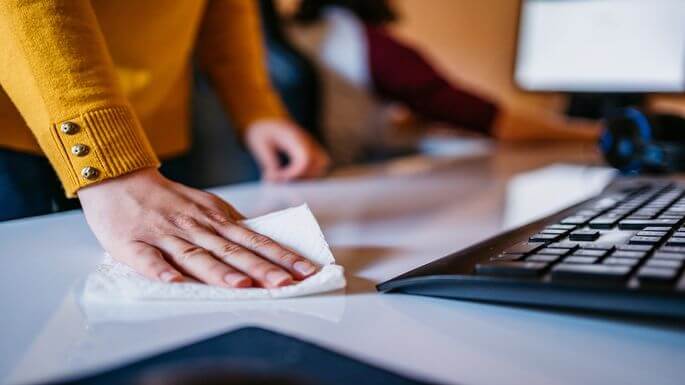Toilet paper, cleaning supplies, and face masks aren’t the only things in short supply right now. Disinfectant wipes for sanitizing the surfaces of your home—and your hands—have also been harder and harder to get these past few weeks.
Fortunately, you don’t have to scour every single grocery store in town to get these essential cleaning items back in your pantry.
After chatting with the health experts, we’ve got all the details on how you can make your own disinfectant wipes at home. Here’s the scoop on everything you’ll need to create a full supply of DIY cleaning wipes during quarantine.
Ingredients for DIY wipes
You won’t need a whole lot of ingredients to make your very own cleaning wipes at home. Here’s a breakdown of what you’ll need to get started.
- High-absorbency paper towels (or microfiber cloths)
- One-third cup bleach (or 1¼ cup 70% isopropyl alcohol)
- Aloe vera gel or coconut oil, about a tablespoon
- Water
- Rubber gloves
- Plastic container
How to make your sanitizing wipes
Making your own sanitizing wipes is incredibly easy, and varies only slightly depending on the type of wipes you’d like to make. If you’re in need of wipes to clean surfaces, bleach is better. But if you’d like to make hand wipes, alcohol plus aloe vera gel or coconut oil is the way to go. Here’s a step-by-step breakdown of how to make DIY wipes for all of your cleaning needs.
Step 1: Measure out your cleaning solution
To make surface sanitizing wipes, start by measuring out one-third cup bleach and combining it with a gallon of water, says cleaning expert Jon Gibbons of Smart Vacuums. While some people like to use isopropyl alcohol, Gibbons prefers bleach for cleaning surfaces.
“Both alcohol and bleach are effective at disinfecting, but alcohol is better for smaller surfaces—while bleach kills a wider range of viruses and bacteria,” he says.
For hand wipes, opt for 1¼ cup of 70% isopropyl alcohol, mixed with quarter cup water. But remember: These will be used on your skin.
“Consider adding a nourishing, moisture-enhancing ingredient such as aloe vera or coconut oil to give your hands some extra attention,” suggests health and wellness expert Caleb Backe of Maple Holistics. “Both of these natural ingredients also contain antimicrobial properties to fight off germs.”
Step 2: Mix the solu
After you’ve measured out your ingredients, use a pair of gloves (particularly for the bleach wipes) and a spoon to thoroughly mix your solution. (You may want to briefly microwave the coconut oil, which is solid at room temperature, to make it easier to blend.)
Step 3: Soak the wipes
Once you’ve mixed everything together thoroughly, place a stack of your chosen material into the storage container you’d like to use. High-absorbency paper towels will work, although Gibbons prefers cut-to-size reusable microfiber cloths—as these can be washed in the laundry machine and reused. Pour your mixture over it, and cover as many wipes as possible while still avoiding overflow. Close the lid on your airtight container and store it somewhere cool.
Final things to keep in mind
Regardless of what type of homemade wipe you decide to make, remember that chemical solutions containing bleach or alcohol can be harmful to certain surfaces or your home, and dangerous if ingested.
For this reason, Backe cautions against using bleach wipes on children's toys or objects that come in contact with the mouth. For our part, we’d also recommend keeping all of these DIY wipes away from any antiques or valuable furniture pieces.
And although you might be tempted to take your newfound DIY wipe talents and create container upon container of them, keep in mind the shelf life of homemade wipes is much shorter than the ones you’d buy at the store.
“The potency of alcohol wears off when it’s left to evaporate,” says Backe.
To avoid this, be sure to store your wipes in an airtight container, and replace them every week (or sooner) for a fresher solution.
Claim your home and get tips on remodeling and design inspiration.


